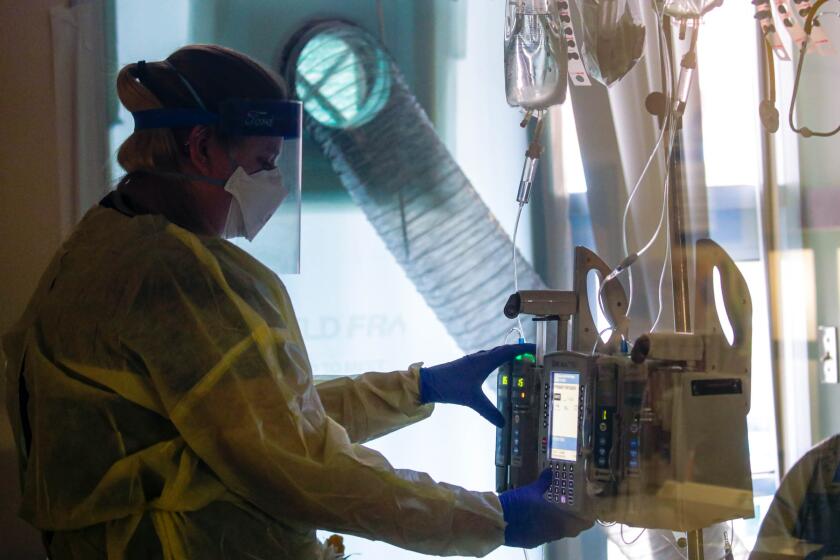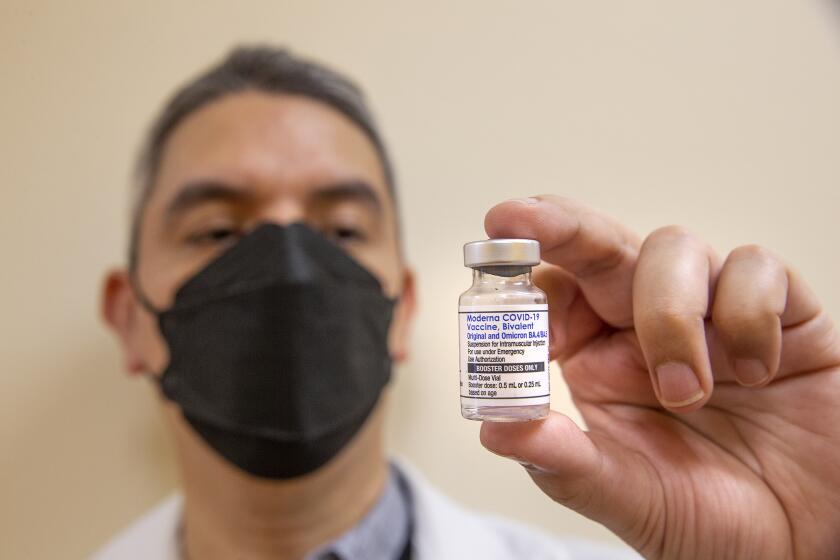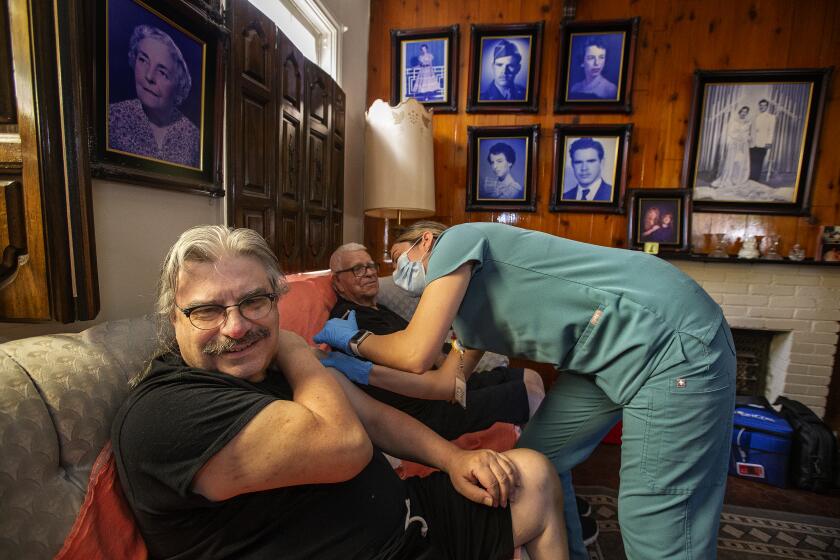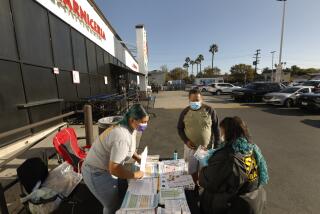L.A. County COVID surge raises prospect of return to indoor masking order
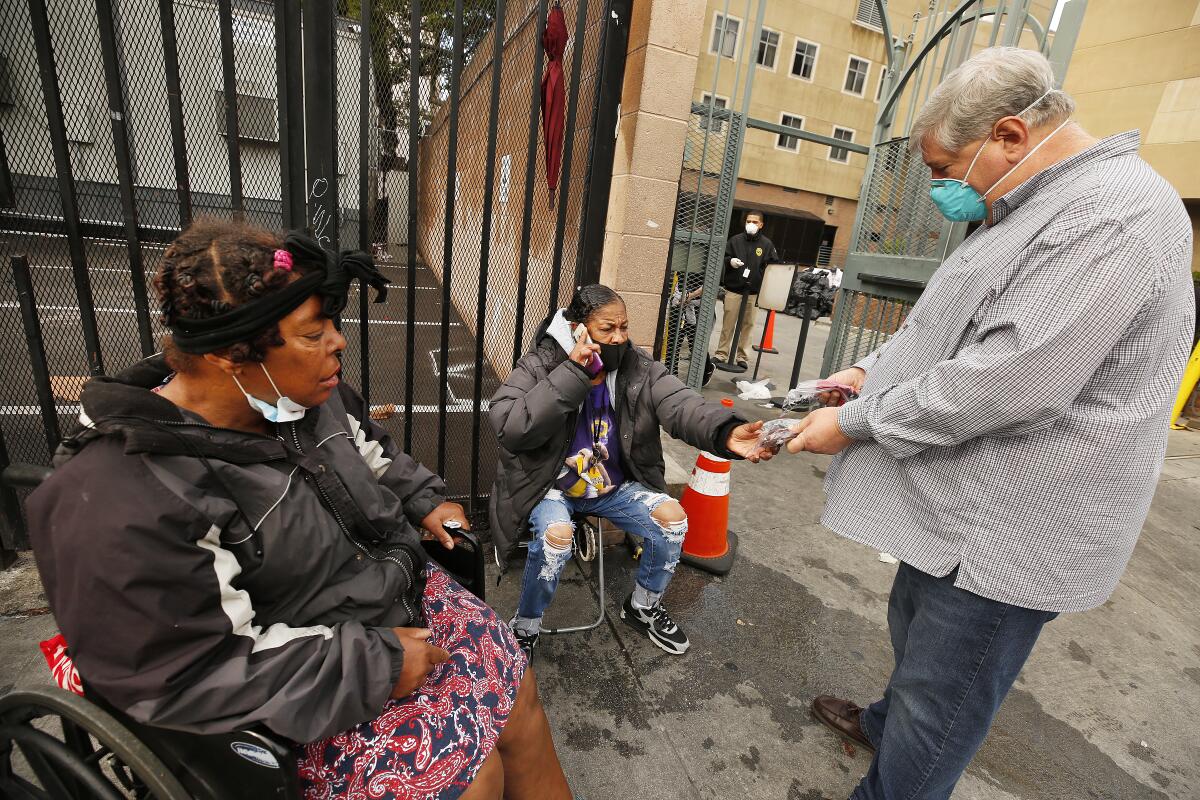
- Share via
Coronavirus case and hospitalization rates have risen dramatically in Los Angeles County, which on Thursday reentered the medium COVID-19 community level for the first time since the end of the summer Omicron wave.
The increasing rates of hospitalization — which are so rapid they are coming as a surprise to officials — raise the prospect of a return to an indoor mask mandate in L.A. County in the coming weeks, based on previously established criteria by local public health officials. But it remains uncertain whether that threshold will be met.
L.A. County’s coronavirus case rate has been increasing since late October, triple what it was in the autumn low. For the week that ended Thursday, L.A. County was recording 2,710 cases a day — or 188 cases a week for every 100,000 residents. A case rate of 100 or more is considered high. The autumn low was a weekly rate of 60, set on Oct. 21.
Hospitalizations also are up dramatically. According to the U.S. Centers for Disease Control and Prevention, there were 1,196 new admissions of coronavirus-positive patients for the week that ended Tuesday — triple the rate from the beginning of November.
That’s 11.9 new weekly hospitalizations for every 100,000 residents. A rate exceeding 10 is enough to send L.A. County to the medium COVID-19 community level.
The findings, published by the U.S. Centers for Disease Control and Prevention, show that COVID-19 can still cause severe and fatal outcomes in children too young to be vaccinated.
“These numbers clearly demonstrate that COVID is still with us,” L.A. County Public Health Director Barbara Ferrer said Thursday. “We feel like we’re seeing a much more rapid acceleration than we want to be seeing at this point.”
Should hospital measures worsen, L.A. County could be on track for the return of a mandatory mask mandate in indoor public settings. But that threshold — if it were to be reached — is probably a few weeks away.
To get there, the case rate would need to top 200 a week for every 100,000 residents. L.A. County could hit that threshold next week.
But before a mask mandate were triggered, the percentage of hospital beds used by coronavirus-positive patients also would need to exceed 10%, a level reached only during the two prior COVID-19 winter surges, the deadliest of the pandemic. The current figure is 5.6%, which is up from around 2% at the start of November.
Ferrer said she doesn’t expect L.A. County to hit that hospitalization rate anytime soon. “I don’t think it’ll be there next week. I’d be very surprised,” Ferrer said. “It would mean that hospitalizations are really going up very, very quickly, much more quickly than we usually see.”
If L.A. County does hit all the benchmarks to trigger a new mask order, officials could decide to implement the rule a couple of weeks later, Ferrer said.
Over the summer, L.A. County hit the threshold to initiate a new mask order in response to rising cases and hospitalizations, triggering a countdown for the order to go into effect two weeks later, in late July. But that order never went into place, as case and hospitalization rates dipped just in time.
Los Angeles County health experts are carefully watching a rise in coronavirus cases in Britain, France, Germany and Italy as a potential predictor for trending cases in the United States.
“We’ll have to look at the rate of increase and what we’re seeing in terms of that to decide what that time frame would be,” Ferrer said. “And then, as we’ve done in the past, as soon as we see the numbers that show us that transmission has lowered and that concerns at our hospitals are lower … we’d go ahead and lift” the mask order.
Ferrer said her counterpart at the state level, Dr. Tomás Aragón, the California public health director and health officer, told her he’s also concerned “that our healthcare system could really face some very difficult times ahead” — not only because of COVID-19, but the flu and RSV, or respiratory syncytial virus.
For weeks, children’s hospitals throughout California have reported being stressed by RSV and other viral illnesses, causing Orange County to declare a public health emergency. Some San Diego County hospitals have been forced to set up overflow tents outside their emergency departments.
Fresno County on Thursday said the strain has extended to its adult hospitals. “As a result, several hospitals in our area are working over capacity and their emergency rooms are close to disaster levels,” the Fresno County Department of Public Health said in a statement. Fresno County has reissued a policy in which not all 911 patients are transferred to hospitals if paramedics determine they don’t need emergency care.
In L.A. County, children’s hospitals are stressed, and other facilities are preparing for increasing hospitalizations in the coming weeks, Ferrer said. But overall, “at this point, we do not have here in L.A. County an emergency situation,” she said.
But the health system could face threats if conditions worsen. The county health officer, Dr. Muntu Davis, is meeting with hospitals this week to discuss the current strain on the system.
“If our healthcare system experiences a lot of stress, we’re all at a very big risk,” Ferrer said. L.A. County’s hospital system has experienced stress in both of the last winters, and it’s “something we don’t really want to experience again.”
Ferrer said she’s personally seen more people wearing masks recently, amid concerns of rising RSV and flu cases.
A confluence of respiratory illnesses has some California officials warning of a possible triple threat that could strain healthcare systems.
“I’m going to be honest: We had more people report to us positive COVID tests after they came back from Thanksgiving than we’ve ever had before. So there just is a lot of transmission that’s going on,” Ferrer said.
“I know nobody is anxious to hear this message from us that we need to protect each other again, but [if we want to] take actions at this point to help our healthcare system, we have to do it now,” Ferrer said. “We have to really make sure that we’re able to do everything we can to reduce the number of people that are going to need a hospital bed.”
The COVID-19 death rate remains stable in L.A. County, at around 60 per week. But if cases continue to rise, so too will deaths, eventually.
There remains uncertainty over how bad this winter’s COVID-19 wave will be.
Just before Thanksgiving, Dr. Anthony Fauci, President Biden’s outgoing chief medical advisor for the pandemic, said a note of optimism emerged from Singapore. The city recently experienced a big wave in coronavirus cases fueled by the Omicron subvariant XBB but did not see a resulting major increase in hospitalizations.
If more people get the updated COVID-19 booster and take steps like masking up indoors in public, that could do a lot to stem transmission, Dr. Mark Ghaly, the California health and human services secretary, said in a forum Thursday.
Ghaly expressed optimism that more people were getting the bivalent booster.
“If you look at just yesterday, we’re nearly 40% higher in the number of [updated boosters] that we’ve calculated were given in California ... than the seven-day average,” Ghaly said in an online talk with the Public Policy Institute of California. “And so what that tells me is Californians are starting to get the message. They’re starting to see the real reality of the threat.”
It remains critical that unvaccinated people get their shots and vaccinated people get their boosters, Xavier Becerra, the U.S. Health and Human Services secretary, said at the PPIC forum. Only 16% of the 28.7 million Californians eligible for the updated booster shot have received one.
“The people who are dying today are principally people who are unvaccinated or haven’t gotten an up-to-date vaccine, so the strength of their immunity has waned,” Becerra said. Even though weekly COVID-19 deaths are averaging about 300 a day nationally — far better than the 3,000 a day during the worst surges — the number is still equivalent to a jetliner crashing every day, he added.
More to Read
Sign up for Essential California
The most important California stories and recommendations in your inbox every morning.
You may occasionally receive promotional content from the Los Angeles Times.
